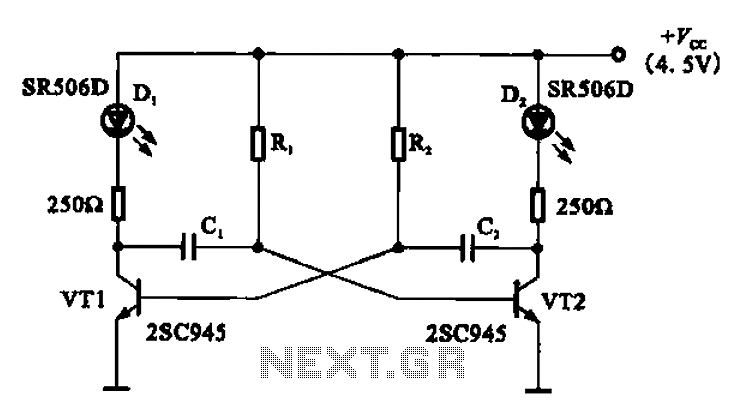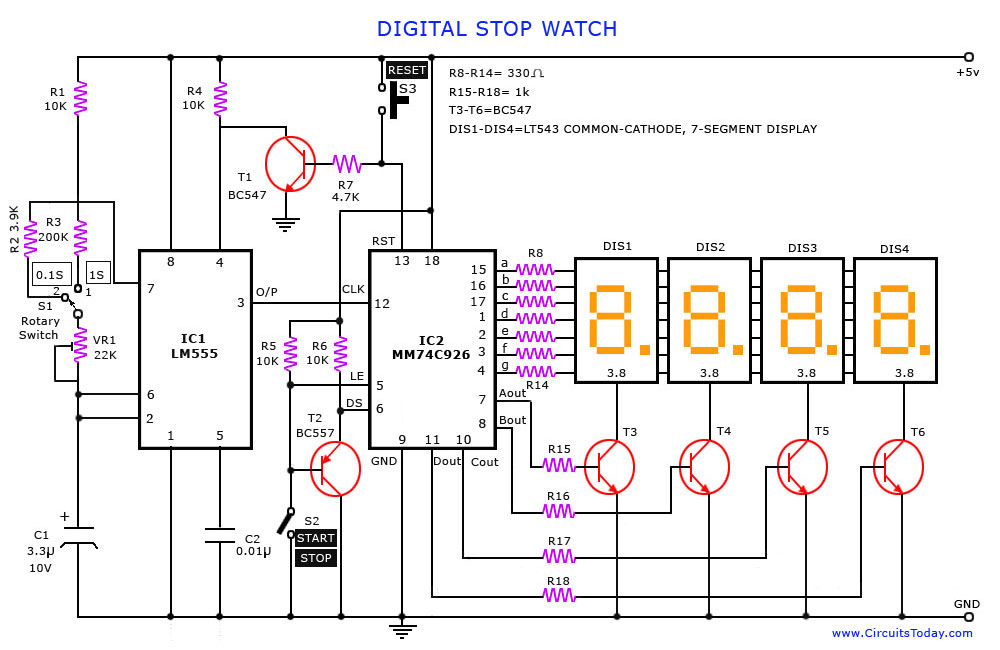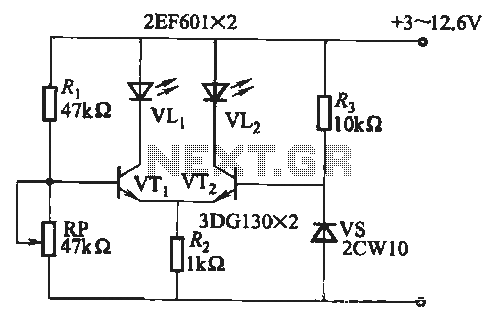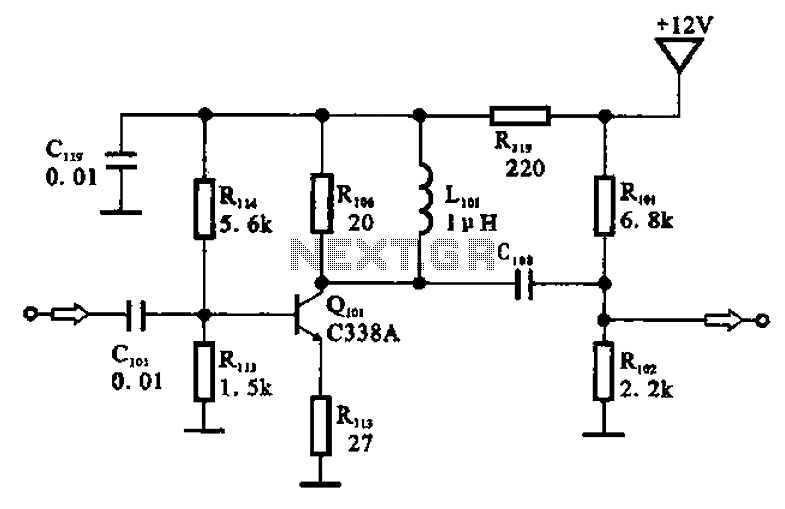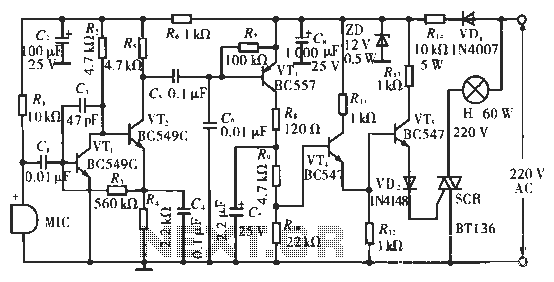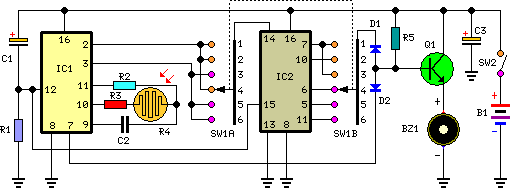
Improved 3 Transistor Audio Amp (80 milliwatt) circuit
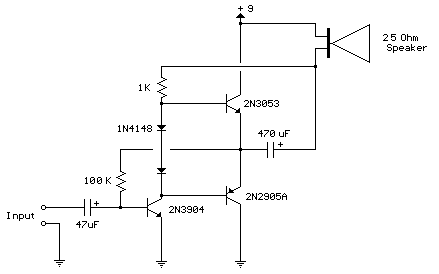
This circuit is similar to the previous one but employs positive feedback to enhance the amplitude delivered to the speaker. It was adapted from a small five-transistor radio that utilizes a 25-ohm speaker. In the prior circuit, the load resistor for the driver transistor is directly connected to the positive supply, which presents a drawback: as the output swings positive, the voltage drop across the 470-ohm resistor decreases, leading to a reduction in base current for the upper NPN transistor. Consequently, the output cannot reach the positive supply voltage due to the lack of voltage across the 470-ohm resistor, resulting in insufficient base current for the NPN transistor. This revised circuit addresses the issue to some extent, allowing for a larger voltage swing and potentially increased output power, although the exact improvement would require extensive testing. The output is still limited to a few volts when using small transistors since the peak current is unlikely to exceed 100 mA into a 25-ohm load. However, this configuration is an enhancement over the previous design. In this circuit, the 1k-ohm load resistor is connected to the speaker, enabling the voltage across the 1k resistor to decrease when the output swings negative, which helps turn off the upper NPN transistor. Conversely, when the output swings positive, the charge on the 470 µF capacitor assists in turning on the upper NPN transistor. The original circuit from the radio included a 300-ohm resistor in the position of the two diodes, but this has been modified to use two diodes to allow the amplifier to function at lower voltages with reduced distortion. The transistors used, 2N3053 and 2N2905, are components from the previous circuit and could be substituted with smaller alternatives. Most small transistors capable of handling 100 mA or more can be utilized; however, options like the 2N3904 or 2N3906 may be slightly undersized but could function adequately at lower volumes. The two diodes provide a relatively constant bias voltage as the battery discharges, which minimizes crossover distortion. It is essential to ensure that the idle current remains between 10 to 20 milliamps without a signal, and that the output transistors do not overheat under load. The circuit is compatible with a standard 8-ohm speaker, although the output power may be slightly reduced. To optimize performance, it is advisable to select a resistor in place of the 100k resistor to set the output voltage at half the supply voltage (4.5 volts). This resistor can range from 50k to 700k depending on the gain of the transistor used, particularly where the 3904 is indicated.
This circuit utilizes positive feedback to improve speaker amplitude, enhancing performance over previous designs. The configuration addresses the limitations of direct connection to the positive supply by incorporating a feedback mechanism that allows for greater voltage swings. The use of a 1k-ohm load resistor connected to the speaker plays a critical role in modulating the transistor operation, ensuring that the upper NPN transistor can be effectively turned off when the output is negative. The inclusion of a 470 µF capacitor is vital, as it provides the necessary charge to assist in turning on the upper NPN transistor during positive swings, which is essential for maximizing output power.
The choice of diodes instead of a resistor for biasing allows the circuit to operate efficiently at lower voltages, thus reducing distortion and improving audio quality. The specified transistors, while effective, can be substituted with smaller alternatives that meet the current handling requirements. It is crucial to monitor the idle current to maintain proper operation and prevent overheating, particularly under load conditions. The circuit's compatibility with an 8-ohm speaker allows for versatility in application, although careful consideration should be given to the output power levels.
For optimal performance, tuning the resistor value to achieve a balanced output voltage is advisable. This adjustment can significantly influence the overall gain and efficiency of the circuit, ensuring that the amplifier operates within desired parameters while maximizing audio fidelity. The design illustrates a practical approach to enhancing audio output in compact electronic devices, making it suitable for various applications in consumer electronics.This circuit is similar to the one above but uses positive feedback to get a little more amplitude to the speaker. I copied it from a small 5 transistor radio that uses a 25 ohm speaker. In the circuit above, the load resistor for the driver transistor is tied directly to the + supply. This has a disadvantage in that as the output moves positive, the drop across the 470 ohm resistor decreases which reduces the base current to the top NPN transistor. Thus the output cannot move all the way to the + supply because there wouldn`t be any voltage across the 470 resistor and no base current to the NPN transistor.
This circuit corrects the problem somewhat and allows a larger voltage swing and probably more output power, but I don`t know how much without doing a lot of testing. The output still won`t move more than a couple volts using small transistors since the peak current won`t be more than 100mA or so into a 25 ohm load.
But it`s an improvement over the other circuit above. In this circuit, the 1K load resistor is tied to the speaker so that as the output moves negative, the voltage on the 1K resistor is reduced, which aids in turning off the top NPN transistor. When the output moves positive, the charge on the 470uF capacitor aids in turning on the top NPN transistor.
The original circuit in the radio used a 300 ohm resistor where the 2 diodes are shown but I changed the resistor to 2 diodes so the amp would operate on lower voltages with less distortion. The transistors shown 2n3053 and 2n2905 are just parts I used for the other circuit above and could be smaller types.
Most any small transistors can be used, but they should be capable of 100mA or more current. A 2N3904 or 2N3906 are probably a little small, but would work at low volume. The 2 diodes generate a fairly constant bias voltage as the battery drains and reduces crossover distortion. But you should take care to insure the idle current is around 10 to 20 milliamps with no signal and the output transistors do not get hot under load.
The circuit should work with a regular 8 ohm speaker, but the output power may be somewhat less. To optimize the operation, select a resistor where the 100K is shown to set the output voltage at 1/2 the supply voltage (4. 5 volts). This resistor might be anything from 50K to 700K depending on the gain of the transistor used where the 3904 is shown.
🔗 External reference
This circuit utilizes positive feedback to improve speaker amplitude, enhancing performance over previous designs. The configuration addresses the limitations of direct connection to the positive supply by incorporating a feedback mechanism that allows for greater voltage swings. The use of a 1k-ohm load resistor connected to the speaker plays a critical role in modulating the transistor operation, ensuring that the upper NPN transistor can be effectively turned off when the output is negative. The inclusion of a 470 µF capacitor is vital, as it provides the necessary charge to assist in turning on the upper NPN transistor during positive swings, which is essential for maximizing output power.
The choice of diodes instead of a resistor for biasing allows the circuit to operate efficiently at lower voltages, thus reducing distortion and improving audio quality. The specified transistors, while effective, can be substituted with smaller alternatives that meet the current handling requirements. It is crucial to monitor the idle current to maintain proper operation and prevent overheating, particularly under load conditions. The circuit's compatibility with an 8-ohm speaker allows for versatility in application, although careful consideration should be given to the output power levels.
For optimal performance, tuning the resistor value to achieve a balanced output voltage is advisable. This adjustment can significantly influence the overall gain and efficiency of the circuit, ensuring that the amplifier operates within desired parameters while maximizing audio fidelity. The design illustrates a practical approach to enhancing audio output in compact electronic devices, making it suitable for various applications in consumer electronics.This circuit is similar to the one above but uses positive feedback to get a little more amplitude to the speaker. I copied it from a small 5 transistor radio that uses a 25 ohm speaker. In the circuit above, the load resistor for the driver transistor is tied directly to the + supply. This has a disadvantage in that as the output moves positive, the drop across the 470 ohm resistor decreases which reduces the base current to the top NPN transistor. Thus the output cannot move all the way to the + supply because there wouldn`t be any voltage across the 470 resistor and no base current to the NPN transistor.
This circuit corrects the problem somewhat and allows a larger voltage swing and probably more output power, but I don`t know how much without doing a lot of testing. The output still won`t move more than a couple volts using small transistors since the peak current won`t be more than 100mA or so into a 25 ohm load.
But it`s an improvement over the other circuit above. In this circuit, the 1K load resistor is tied to the speaker so that as the output moves negative, the voltage on the 1K resistor is reduced, which aids in turning off the top NPN transistor. When the output moves positive, the charge on the 470uF capacitor aids in turning on the top NPN transistor.
The original circuit in the radio used a 300 ohm resistor where the 2 diodes are shown but I changed the resistor to 2 diodes so the amp would operate on lower voltages with less distortion. The transistors shown 2n3053 and 2n2905 are just parts I used for the other circuit above and could be smaller types.
Most any small transistors can be used, but they should be capable of 100mA or more current. A 2N3904 or 2N3906 are probably a little small, but would work at low volume. The 2 diodes generate a fairly constant bias voltage as the battery drains and reduces crossover distortion. But you should take care to insure the idle current is around 10 to 20 milliamps with no signal and the output transistors do not get hot under load.
The circuit should work with a regular 8 ohm speaker, but the output power may be somewhat less. To optimize the operation, select a resistor where the 100K is shown to set the output voltage at 1/2 the supply voltage (4. 5 volts). This resistor might be anything from 50K to 700K depending on the gain of the transistor used where the 3904 is shown.
🔗 External reference
Warning: include(partials/cookie-banner.php): Failed to open stream: Permission denied in /var/www/html/nextgr/view-circuit.php on line 713
Warning: include(): Failed opening 'partials/cookie-banner.php' for inclusion (include_path='.:/usr/share/php') in /var/www/html/nextgr/view-circuit.php on line 713
